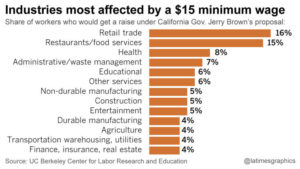California is the site of a bold economic experiment and her businesses and citizens are the guinea pigs.
Last month, California Gov. Jerry Brown signed in to law, the minimum wage increase from $10 to $15 by year 2022. And we, the Restaurant Technology Guys, are here to talk you through it. We are going to break down all this information into four separate articles: the facts and benefits, possible disruptions and consequences, how the wage increase will affect restaurants and how the increase will affect customers.
Here’s what you should know:
- California’s minimum wage is now $10. Unions say that is less than $21,000 a year for a full-time worker. Last year, the Los Angeles city council voted to increase its minimum wage from $9 to $15 by 2020. In 2014, San Francisco voters passed a proposition that will raise the minimum wage from $12.25 to $13 on July 1 and to $15 by 2018. For the rest of the state, the minimum wage is set to increase to $10.50 next year and incrementally until the wage reaches $15 in 2022.
- There is a built-in ‘out’ to this law. The most recent deal includes “off-ramps,” or pauses in the annual minimum wage hike in case of negative economic conditions, including negative job growth or retail sales. Gov. Jerry Brown can also act by Sept. 1 of each year to pause the next year’s wage increase if a budget deficit is forecasted of more than one percent of annual revenue.
- This affects all hourly workers and the businesses that employ them, though businesses with 25 employees or less would have an extra year to raise their wages. Nearly 2.2 million workers are paid the minimum wage in California, according to the governor’s office. The California Chamber of Commerce has opposed any statewide ballot measure for a $15 minimum wage, saying it would create burdensome costs for businesses and the government.
- When the Golden State’s minimum wage increases to $15, it will be the highest statewide minimum in the nation.
The benefits:
- Low-wage workers will be paid more and their standard of living will improve.
- More money will stay in Los Angeles rather than being paid to stockholders who live elsewhere.
- The low-wage workers who receive the pay increase are likely to spend all of the money – households with incomes in the $30,000 to $39,999 range spend 106 percent of their pre-tax income. In contrast, households with incomes of $70,000 and higher, which include most stockholders, spend only 63 percent of their pre-tax income. More spending and economic stimulus occurs when money is in the pockets of lower-income workers than when it is in the pockets of higher income stockholders.
- Los Angeles workers would receive $7.6 billion more a year in pay with a $15 minimum wage. The average full-time, low-wage worker, who is working 2,150 hours a year and paid $9.55 an hour, would receive $11,729 more in annual pay. The average part-time, low-wage worker, who is working 1,031 hours a year and paid $8.89 an hour, would receive $6,297 more in annual pay. The wage increase would benefit 811,000 workers, 454,000 of them full-time and 357,000 of them part-time.
- Businesses will benefit from having more money spent in the local economy and by having a higher-paid labor force that is more stably housed, reducing employee turnover and the associated costs for recruiting and training new employees. It costs an estimated 30 percent of a worker’s annual salary to replace that worker, so reducing the frequency of worker turnover results in significant cost savings for employers.
Most full-time, low-wage (less than $15 an hour) employees are working in retail and service industries that serve Los Angeles-area residents. Only 22 percent of low-wage workers are employed by industries like manufacturing, wholesale trade or information (movies, internet and publishing) that send products outside of the Los Angeles region. Thus, four out of five low-wage workers are doing things that serve other Los Angeles residents.
The graphic above, provided by the LA Times, represents the share of workers who would get a raise under the new law. Take note of the top two categories: Retail trade and Restaurant/Food Services. Combined, they make up 31%, far exceeding any other category.
California restaurants and retail stores are going to be ground zero for the impact of the proposed statewide $15 minimum wage.
In the upcoming weeks, we are going to discuss the possible consequences and disruptions the new law could have upon minority youth, jobs, restaurants, employees and how this will affect smaller, more in-land cities like Fresno, Chico and Merced.
Need to pass the time before our next article? Then check out Custom Business Solution for all your restaurant technology needs!


